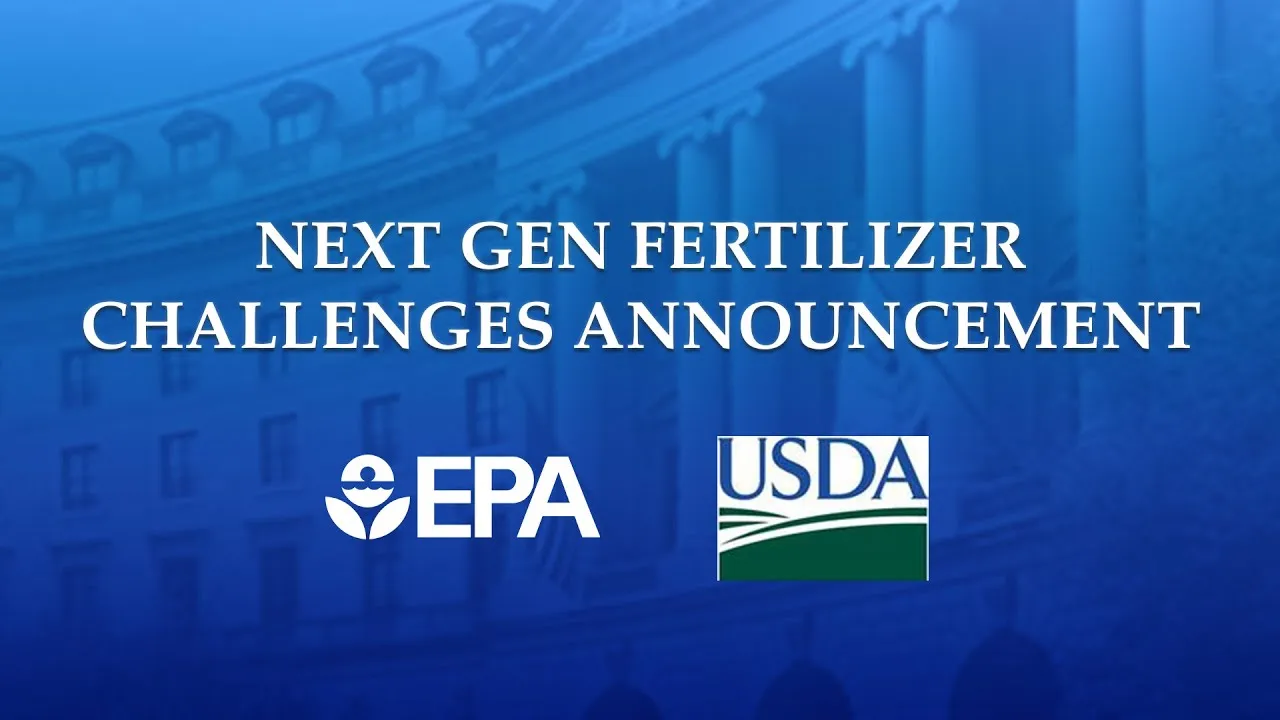


USDA ed EPA annunciano i vincitori della Next Gen Fertilizer Innovations Challenge
WASHINGTON, 19 ottobre 2021 - Oggi, il Dipartimento dell'agricoltura degli Stati Uniti e l'Agenzia per la protezione ambientale degli Stati Uniti (EPA) hanno annunciato i vincitori della Next Gen Fertilizer Innovations Challenge, la seconda di una partnership e competizione congiunta USDA-EPA in due parti sui fertilizzanti ad alta efficienza (EEF) per promuovere la sostenibilità agricola negli Stati Uniti. L'obiettivo della competizione è migliorare l'efficienza dei fertilizzanti per aumentare le rese delle colture riducendo al contempo l'impatto dei fertilizzanti sull'ambiente.

I vincitori della sfida hanno presentato concetti per nuove tecnologie in grado di ridurre gli effetti ambientali dell'azoto e del fosforo derivanti dall'agricoltura moderna, mantenendo o aumentando al contempo le rese delle colture. Le soluzioni vincenti utilizzano nanoparticelle che richiedono meno fertilizzante e rilasciano nutrienti su richiesta alle piante in crescita, per poi biodegradarsi in sostanze innocue o persino nutrienti; supportano una maggiore crescita delle piante con la stessa o minore applicazione di fertilizzante; e altri approcci.
“Farmers, ranchers, and foresters are well-positioned to be leaders in tackling climate change through technological innovation,” said Acting USDA Chief Scientist Hubert Hamer. “Through programs like the Next Gen Fertilizer Innovations Challenge, USDA is partnering with the private sector to find new climate-smart solutions that are good for farmers and good for the environment.”
“The goal of the challenge is to develop and use innovative and affordable technologies to reduce environmental impacts of modern agriculture on our air, land, and water, while maintaining agricultural productivity and profitability,” said Wayne Cascio, acting principal deputy assistant administrator for science for EPA’s Office of Research and Development. “We are excited about the possibilities and continued new work in this area.”
The winning concepts include a range of solutions that can improve environmental outcomes, including reduced nitrous oxide emissions—the largest source of greenhouse gas emissions from agriculture— while maintaining or increasing crop yields.
I vincitori includono:
Soluzioni di livello 1 (premio di $ 17.500):
Dott. Christopher Hendrickson, Aqua-Yield Operations LLC, Draper, Utah, per un fertilizzante nano-intelligente.
Taylor Pursell, Pursell Agri-Tech, Sylacauga, Ala., for “Urea 2.0,” which replaces the conventional urea core with a customizable mixture of materials to provide fertilizers tailored to local needs.
Soluzioni di livello 2 (premio di $ 10.000):
Dott. Kuide Qin, Verdesian Life Sciences, Cary, NC, per l'utilizzo di tecnologie di miscelazione innovative volte a migliorare le prestazioni della nitrapirina standard del settore, garantendone un'efficacia prolungata, una minore lisciviazione dei nitrati e prevenendo la corrosione delle attrezzature agricole.
Dr. Catherine Roue, Fertinagro Biotech International, Portage, Mich., for “Phosphate Liberation Booster” technology, which uses secretions from phosphate-starved plants to boost plant uptake so less fertilizer may be added and legacy phosphorus can be accessed.
Chandrika Varadachari, Agtec Innovations Inc., Los Altos, Calif., for “Smart-N,” which is a smart-fertilizer that releases nutrients on-demand by the crop and which creates a chemical “cage” for urea that dissolves into plant nutrients.
Soluzioni di livello 3 (menzione d'onore):
Dott. Jaroslav Nisler, dell'Istituto di botanica sperimentale dell'Accademia ceca delle scienze, Repubblica Ceca, per l'utilizzo di derivati dell'ormone della crescita delle piante MTU, che aiuta a creare periodi di crescita più lunghi, protezione dallo stress, piante più grandi e potenzialmente una minore perdita di nutrienti per unità di fertilizzante applicato.
Dr. Leanne Gilbertson, Civil and Environmental Engineering Department at the University of Pittsburgh, Penn., for creating a “protected fertilizer package,” which can carry nutrients through soil pores to the area around the plant roots.
Dr. Robert Neidermyer, Holganix LLC, Aston, Penn., for “Bio 800+,” a microbial inoculant that harnesses the power of over 800 species of soil microbes, kelp, and other soil amending ingredients to promote greater crop production and plant health.
Paul Mullins, Brandon Products Ltd., Ireland, for “BBS-1,” a biostimulant derived from seaweed extract that is applied as a fertilizer coating to improve nitrogen-uptake in root cells.
L'USDA e l'EPA stanno coordinando le sfide dell'EEF con il Fertilizer Institute (TFI), l'International Fertilizer Development Center (IFDC), The Nature Conservancy (TNC) e la National Corn Growers Association (NCGA).
The competition launched on August 26, 2020. Part two of the first challenge, “EEFs: Environmental and Agronomic Challenge,” is ongoing. More information can be found at: www.epa.gov/innovation/next-gen-fertilizer-challenges.
USDA touches the lives of all Americans each day in so many positive ways. In the Biden-Harris Administration, USDA is transforming America’s food system with a greater focus on more resilient local and regional food production, fairer markets for all producers, ensuring access to safe, healthy and nutritious food in all communities, building new markets and streams of income for farmers and producers using climate smart food and forestry practices, making historic investments in infrastructure and clean energy capabilities in rural America, and committing to equity across the Department by removing systemic barriers and building a workforce more representative of America. To learn more, visit Italiano: www.usda.gov.
-
Zinc Chloride: a reliable stabilizer for ice dye color salts in the dye industryNotiziaAug.11,2025
-
Propargyl Alcohol: A Multifunctional Chemical Additive in the Industrial FieldNotiziaAug.11,2025
-
Phosphorus Pentasulfide: a special material that combines moisture absorption and basic chemical valueNotiziaAug.11,2025
-
Natural Pesticides: The Environmental Choice for Green Prevention and ControlNotiziaAug.11,2025
-
Grass Pesticide: the invisible guardian of green lawnsNotiziaAug.11,2025
-
Dimethyl Sulfoxide: Key Assistance in Sample Management and Drug ScreeningNotiziaAug.11,2025
-
Uncover the Benefits of Sodium ChlorateNotiziaJun.24,2025


















